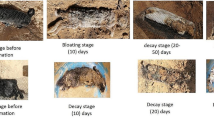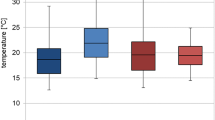Abstract
As a result of criminal activity, human bodies are sometimes dismembered and concealed within sealed, plastic waste sacks. Consequently, due to the inhibited ingress of insects and dismemberment, the rate of decomposition of the body parts within may be different to that of whole, exposed bodies. Correspondingly, once found, an estimation of the postmortem interval may be affected and lead to erroneous inferences. This study set out to determine whether insects were excluded and how rate of decomposition was affected inside such plastic sacks. The limbs, torsos and heads of 24 dismembered pigs were sealed using nylon cable ties within plastic garbage sacks, half of which were of a type claimed to repel insects. Using a body scoring scale to quantify decomposition, the body parts in the sacks were compared to those of ten exposed, whole pig carcasses. Insects were found to have entered both types of plastic sack. There was no difference in rate of decomposition in the two types of sack (F 1,65 = 1.78, p = 0.19), but this was considerably slower than those of whole carcasses (F 1,408 = 1453, p < 0.001), with heads showing the largest differences. As well as a slower decomposition, sacks resulted in formation of some adipocere tissue as a result of high humidity within. Based upon existing methods, postmortem intervals for body parts within sealed sacks would be significantly underestimated.



Similar content being viewed by others
References
Preuß J, Strehler M, Dressler J et al (2006) Dumping after homicide using setting in concrete and/or sealing with bricks—six case reports. Forensic Sci Int 159:55–60. doi:10.1016/j.forsciint.2005.09.010
Toms C, Rogers CB, Sathyavagiswaran L (2008) Investigation of homicides interred in concrete—the Los Angeles experience. J Forensic Sci 53:203–207. doi:10.1111/j.1556-4029.2007.00600.x
Rupp W-R, Thierauf A, Nadjem H, Vogt S (2013) Suicide by carbon dioxide. Forensic Sci Int 231:e30–e32. doi:10.1016/j.forsciint.2013.05.013
Zugibe F, Costello J (1993) The iceman murder - one of a series of contract murders. J Forensic Sci 38:1404–1408
Gitto L, Bonaccorso L, Maiese A et al (2015) A scream from the past: a multidisciplinary approach in a concealment of a corpse found mummified. J Forensic Legal Med 32:53–58. doi:10.1016/j.jflm.2015.02.017
Kojima T, Miyazaki T, Yashiki M et al (1992) Discrepancy between estimated and actual time elapsed after death of a severed head. Forensic Sci Int 56:19–22. doi:10.1016/0379-0738(92)90141-I
Konopka T, Strona M, Bolechała F, Kunz J (2007) Corpse dismemberment in the material collected by the Department of Forensic Medicine, Cracow, Poland. Legal Med 9:1–13. doi:10.1016/j.legalmed.2006.08.008
Delabarde T, Ludes B (2010) Missing in Amazonian jungle: a case report of skeletal evidence for dismemberment. J Forensic Sci 55:1105–1110. doi:10.1111/j.1556-4029.2010.01367.x
Porta D, Amadasi A, Cappella A et al (2016) Dismemberment and disarticulation: a forensic anthropological approach. J Forensic Legal Med 38:50–57. doi:10.1016/j.jflm.2015.11.016
Payne JA (1965) A summer carrion study of the baby pig Sus scrofa Linnaeus. Ecology 46:592–602. doi:10.2307/1934999
Mann RW, Bass WM, Meadows L (1990) Time since death and decomposition of the human body: variables and observations in case and experimental field studies. J Forensic Sci 35:12806J. doi:10.1520/JFS12806J
Simmons T, Adlam RE, Moffatt C (2010) Debugging decomposition data—comparative taphonomic studies and the influence of insects and carcass size on decomposition rate. J Forensic Sci 55:8–13. doi:10.1111/j.1556-4029.2009.01206.x
Simmons T, Cross PA, Adlam RE, Moffatt C (2010) The influence of insects on decomposition rate in buried and surface remains. J Forensic Sci 55:889–892. doi:10.1111/j.1556-4029.2010.01402.x
Anderson GS (2009) Factors that influence insect succession on carrion. In: Byrd JH, Castner J (eds) Forensic entomology: the utility of arthropods in legal investigations, 2nd ed. CRC Press, Boca Raton, FL, pp 201–250
Charabidze D, Bourel B, Hedouin V, Gosset D (2009) Repellent effect of some household products on fly attraction to cadavers. Forensic Sci Int 189:28–33. doi:10.1016/j.forsciint.2009.04.009
Reibe S, Madea B (2010) How promptly do blowflies colonise fresh carcasses? A study comparing indoor with outdoor locations. Forensic Sci Int 195:52–57. doi:10.1016/j.forsciint.2009.11.009
Ahmad A, Ahmad AH, Dieng H et al (2011) Cadaver wrapping and arrival performance of adult flies in an oil palm plantation in northern peninsular Malaysia. J Med Entomol 48:1236–1246
Goff ML (1992) Problems in estimation of postmortem interval resulting from wrapping of the corpse: a case study from Hawaii. J. Agric. Entomol
Haskell NH, Hall RD, Cervenka VJ, Clark MA (1996) On the body: insects’ life stage presence and their postmortem artifacts. In: Haglund WH, Sorg MH (eds) Forensic taphonomy: the postmortem fate of human remains. CRC Press, Boca Raton, FL, pp 415–448
Brenner E (2014) Human body preservation – old and new techniques. J Anat 224:316–344. doi:10.1111/joa.12160
Dent BB, Forbes SL, Stuart BH (2003) Review of human decomposition processes in soil. Environ Geol 45:576–585. doi:10.1007/s00254-003-0913-z
Bourel B, Tournel G, Hédouin V, Gosset D (2004) Entomofauna of buried bodies in northern France. Int J Legal Med 118:215–220. doi:10.1007/s00414-004-0449-0
Simmons T, Walker EA (2010) An investigation into the rate of decomposition of decapitated heads and heads with an attached body. In: Proc. Am. Acad. Forensic Sci. AAFS, pp 368–369
Musshoff F, Klotzbach H, Block W et al (2011) Comparison of post-mortem metabolic changes in sheep brain tissue in isolated heads and whole animals using 1H-MR spectroscopy--preliminary results. Int J Legal Med 125:741–744. doi:10.1007/s00414-010-0463-3
Haglund WD (1993) Disappearance of soft tissue and the disarticulation of human remains from aqueous environments. J Forensic Sci 38:806–815
Byers SN (2010) Introduction to forensic anthropology, 4th edn. Routledge, Boston
Pinheiro J (2006) Decay process of a cadaver. In: Schmitt A, Cunha E, Pinheiro J (eds) Forensic anthropology and medicine: complimentary sciences from recovery to cause of death. Humana Press, Totowa, NJ, pp 85–116
Goff ML (2009) Early post-mortem changes and stages of decomposition in exposed cadavers. Exp Appl Acarol 49:21–36. doi:10.1007/s10493-009-9284-9
Bass WM (1996) Outdoor decomposition rates in Tennessee. In: Haglund WH, Sorg MH (eds) Forensic taphonomy: the postmortem fate of human remains. CRC Press, Boca Raton, FL., pp 181–186
Spicka A, Johnson R, Bushing J et al (2011) Carcass mass can influence rate of decomposition and release of ninhydrin-reactive nitrogen into gravesoil. Forensic Sci Int 209:80–85. doi:10.1016/j.forsciint.2011.01.002
Matuszewski S, Konwerski S, Frątczak K, Szafałowicz M (2014) Effect of body mass and clothing on decomposition of pig carcasses. Int J Legal Med 128:1039–1048. doi:10.1007/s00414-014-0965-5
Franicevic B, Pastor RF (2007) Inter-tidal decomposition patterns in Croatia: an experiment using Sus scrofa pedal elements. In: Proc. Am. Acad. Forensic Sci. AAFS, p 327
Franicevic B (2009) Modes of mutilation in taphonomic context: can sharp force trauma decelerate the decomposition process? In: Proc. Am. Acad. Forensic Sci. AAFS, p 301
Megyesi MS, Nawrocki SP, Haskell NH (2005) Using accumulated degree-days to estimate the postmortem interval from decomposed human remains. J Forensic Sci 50:618–626
Goff ML (2009) Early postmortem changes and stages of decomposition. In: Amendt J, Goff ML, Campobasso CP, Grassberger M (eds) Current concepts in forensic entomology. Springer, Dordrecht, pp 1–24
Cross P, Simmons T, Cunliffe R, Chatfield L (2010) Establishing a taphonomic research facility in the United Kingdom. Forensic Sci Policy Manag Int J 1:187–191. doi:10.1080/19409041003653095
Moffatt C, Simmons T, Lynch-Aird J (2016) An improved equation for TBS and ADD: establishing a reliable postmortem interval framework for casework and experimental studies. J Forensic Sci 61:S201–S207. doi:10.1111/1556-4029.12931
Heaton V, Lagden A, Moffatt C, Simmons T (2010) Predicting the postmortem submersion interval for human remains recovered from UK waterways. J Forensic Sci 55:302–307. doi:10.1111/j.1556-4029.2009.01291.x
Dabbs GR, Connor M, Bytheway JA (2016) Interobserver reliability of the total body score system for quantifying human decomposition. J Forensic Sci 61:445–451. doi:10.1111/1556-4029.12962
Nawrocka M, Frątczak K, Matuszewski S (2016) Inter-rater reliability of total body score-a scale for quantification of corpse decomposition. J Forensic Sci 61:798–802. doi:10.1111/1556-4029.13105
R Development Core Team (2015) R: A language and environment for statistical computing. R Foundation for Statistical Computing, Vienna, Austria
Seongho K (2015) ppcor: partial and semi-partial (part) correlation. R package
Bhadra P, Hart AJ, Hall MJR (2014) Factors affecting accessibility to blowflies of bodies disposed in suitcases. Forensic Sci Int 239:62–72. doi:10.1016/j.forsciint.2014.03.020
Charabidze D, Hedouin V, Gosset D (2015) An experimental investigation into the colonization of concealed cadavers by necrophagous blowflies. J Insect Sci 15:149. doi:10.1093/jisesa/iev129
Moffatt C, Simmons T (2015) Forensic entomology research at the University of Central Lancashire’s TRACES decomposition facility. Antenna Bull R Entomol Soc Special Issue:114–115
Vass AA, Bass WM, Wolt JD et al (1992) Time since death determinations of human cadavers using soil solution. J Forensic Sci 37:1236–1253. doi:10.1520/JFS13311J
Gill-King H (1996) Chemical and ultrastructural aspects of decomposition. In: Haglund WH, Sorg MH (eds) Forensic taphonomy: the postmortem fate of human remains. CRC Press, Boca Raton, FL, pp 93–98
Pakosh CM, Rogers TL (2009) Soft tissue decomposition of submerged, dismembered pig limbs enclosed in plastic bags. J Forensic Sci 54:1223–1228. doi:10.1111/j.1556-4029.2009.01161.x
Forbes SL, Stuart BH, Dent BB (2005) The effect of the method of burial on adipocere formation. Forensic Sci Int 154:44–52. doi:10.1016/j.forsciint.2004.09.109
Widya M, Moffatt C, Simmons T (2012) The formation of early stage adipocere in submerged remains: a preliminary experimental study. J Forensic Sci 57:328–333. doi:10.1111/j.1556-4029.2011.01980.x
Pfeiffer S, Milne S, Stevenson RM (1998) The natural decomposition of adipocere. J Forensic Sci 43:368–370
Fründ H-C, Schoenen D (2009) Quantification of adipocere degradation with and without access to oxygen and to the living soil. Forensic Sci Int 188:18–22. doi:10.1016/j.forsciint.2009.03.005
Mohan Kumar TS, Monteiro FNP, Bhagavath P, Bakkannavar SM (2009) Early adipocere formation: a case report and review of literature. J Forensic Legal Med 16:475–477. doi:10.1016/j.jflm.2009.07.004
Acknowledgements
Thanks to Peter Cross for all his help setting up and carrying out the experiment, Tal Simmons and the MSc anthropology student cohort for help and support, and Viv Heaton for commenting upon the manuscript.
Author information
Authors and Affiliations
Corresponding author
Rights and permissions
About this article
Cite this article
Scholl, K., Moffatt, C. Plastic waste sacks alter the rate of decomposition of dismembered bodies within. Int J Legal Med 131, 1141–1147 (2017). https://doi.org/10.1007/s00414-017-1535-4
Received:
Accepted:
Published:
Issue Date:
DOI: https://doi.org/10.1007/s00414-017-1535-4




